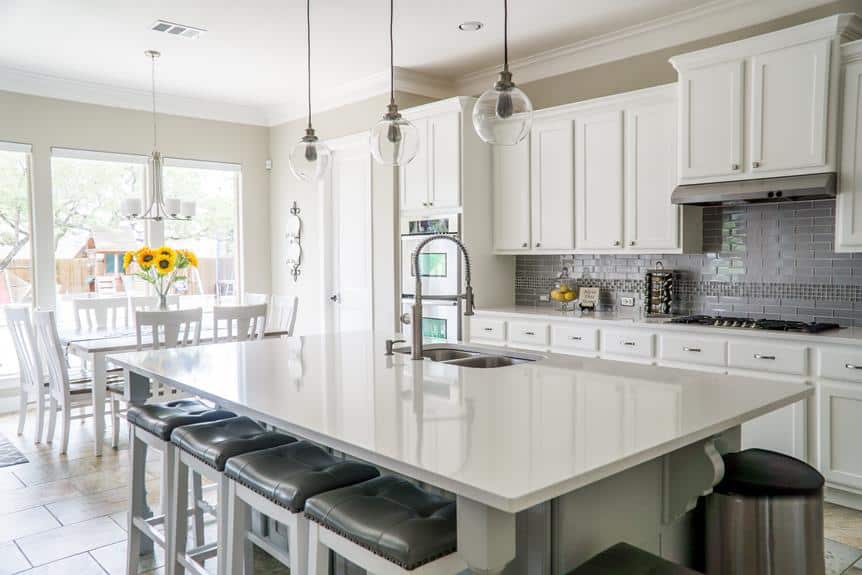To fill a gap between a stove and a cabinet, first measure the gap size to select the right filler. Options include silicone or plastic gap covers that match the countertop height. Custom fillers can also be made to blend with the kitchen design.
Installation is generally easy and results in a neat finish. Keep the filler clean to maintain its condition and the kitchen's cleanliness.
Identifying the Gap Size
To properly fill the gap between the stove and cabinet, measure the width of the space at multiple points along the counter edge to capture any variations using a reliable tape measure. Record the narrowest and widest measurements of the gap.
Choose a filler material, such as T-molding that matches your cabinets for a consistent look. This material can slightly flex to fit variations in the gap's width.
Additionally, measure the depth of the gap to ensure the filler material is cut to the correct length.
This method ensures a tight, professional finish when addressing gaps in kitchen spaces.
Choosing the Right Material
When choosing a material to fill the gap between your stove and cabinets, consider the gap size, kitchen design, material durability, and heat resistance.
A silicone stove counter gap cover is suitable for small gaps, offering a clean look and heat resistance. For gaps around a quarter to half an inch, a backer rod can be used to fill the space effectively and prevent debris accumulation. It can be compressed to fit the gap securely.
For larger gaps, a custom-cut wood board can be installed. Measure the gap and cut the wood to fit the dimensions. Pre-drill holes and screw the board into place for a stable and heat-resistant barrier that matches your cabinetry.
Ensure the material is compatible with your type of stove, be it standard, compact, or commercial, to achieve a seamless fit with your kitchen's aesthetics and a functional solution for the gap.
Custom Gap Cover Solutions
Custom gap cover solutions are designed to fill the space between a stove and cabinets for a better fit and appearance. These are ideal for non-standard gaps larger than what off-the-shelf products can handle. Custom covers address both looks and practicality.
To make a custom gap cover, accurate measurements are taken to ensure a precise fit. Pine project boards are commonly used for these covers because they're affordable and easy to work with. They are cut to size and installed flush against the stove and cabinets for a smooth look.
Other materials, like thin utility plywood panels, are also an option. These panels are useful for creating a level surface behind a peninsula or cabinet row. This solution provides a continuous and stable base, eliminating the gap.
Custom gap covers can also integrate storage options like narrow cabinets, shelves, or hooks, taking advantage of the space for additional kitchen storage. This converts the gap into a practical area for kitchen items, increasing the kitchen's functionality.
Installation Process
To install a custom gap cover, first cut pine boards to fit the space between the stove and cabinet. This step is important for a proper fit to prevent crumbs and spills from falling into the gap.
Next, prepare the boards by drilling pilot holes using a Kreg jig, which helps to attach the boards securely to the cabinet and stove.
Then, screw the boards into place at the front and back for support. Using three filler pieces per side ensures stability and durability.
Maintenance and Cleaning Tips
Regular cleaning of gap covers between the stove and cabinet is essential to prevent dirt and debris buildup, ensuring hygiene and appearance. Whether using plastic or silicone covers, it's important to keep this area clean to avoid bacteria and pest infestations.
Establish a regular cleaning schedule for these covers. Remove them carefully to avoid damage and wash in warm soapy water to remove grease and dirt. Make sure they are completely dry before replacing them to avoid mold or mildew.
Additionally, clean the area around and behind the stove regularly. Grease and food splatters can accumulate there, potentially causing a fire hazard. Clean with a degreaser or a vinegar and water solution, paying attention to crevices where residue may collect.
While gap covers help prevent spills and crumbs from entering the space, maintaining cleanliness in adjacent areas will prolong the life of your gap covers and keep your kitchen clean. Promptly cleaning spills and splatters is recommended for a clean cooking environment.





